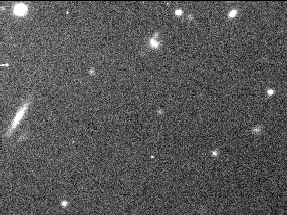
Tarvos (moon)
 Animation of discovery images taken by the CFHT in September 2000 | |
| Discovery[1] | |
|---|---|
| Discovered by | B. J. Gladman et al.[2] |
| Discovery date | September 23, 2000 |
| Designations | |
Designation | Saturn XXI |
| Pronunciation | /ˈtɑːrvɒs/ |
Named after | Tarvos Trigaranus |
| S/2000 S 4 | |
| Adjectives | Tarvian[3] |
| Orbital characteristics[4] | |
| Epoch 2000 January 1.5 | |
| 18.215 Gm | |
| Eccentricity | 0.528 |
| 926.4 d (2.54 yr) | |
| Inclination | 38.6° |
| Satellite of | Saturn |
| Group | Gallic group |
| Physical characteristics | |
| 15+50% −30% km[5] | |
| Albedo | 0.06 assumed[5] |
Spectral type | light red B−V=0.77, R−V=0.57[6] |
| 22.1[7] | |
| 12.9[7] | |
Tarvos /ˈtɑːrvɒs/, or Saturn XXI, is a prograde irregular satellite of Saturn. It was discovered by John J. Kavelaars et al. on September 23, 2000, and given the temporary designation S/2000 S 4. The name, given in August 2003, is after Tarvos, a deity depicted as a bull god carrying three cranes alongside its back from Gaulish mythology.[8]

Orbit

Tarvos orbits Saturn at an average distance of 18 million km in 926 days and is about 15 km in diameter (assuming an albedo of 0.06).[5] It has a high orbital eccentricity of 0.53.[4]

It is a member of the Gallic group of irregular satellites.

Origin
With a similar orbit and displaying a similar light-red colour to Albiorix, Tarvos is thought to have its origin in the break-up of a common progenitor[6][9] or to be a fragment of that body.[10]

References
- ^ "Planetary Satellite Discovery Circumstances". ssd.jpl.nasa.gov.
- ^ "MPEC 2000-Y14 : S/2000 S 3, S/2000 S 4, S/2000 S 5, S/2000 S 6, S/2000 S 10". minorplanetcenter.net. December 19, 2000.
- ^ Per the diminutive Tarvillus in Davis, Daniel (2001). The Development of Celtic Linguistics, 1850-1900. p. 162.
- ^ a b SAT452 from Jacobson, R. A. (2007-06-28). "Planetary Satellite Mean Orbital Parameters". JPL/NASA. Retrieved 2008-01-19.
- ^ a b c Denk, T.; Mottola, S. (2019). Cassini Observations of Saturn's Irregular Moons (PDF). 50th Lunar and Planetary Science Conference. Lunar and Planetary Institute.
- ^ a b Grav, Tommy; Holman, Matthew J.; Gladman, Brett; Aksnes, Kaare (November 2003). "Photometric Survey of the Irregular Satellites". Icarus. 166 (1): 33–45. arXiv:astro-ph/0301016. Bibcode:2003Icar..166...33G. doi:10.1016/j.icarus.2003.07.005.
- ^ a b Denk, Tilmann; Mottola, Stefano; Tosi, Frederico; Bottke, William F.; Hamilton, Douglas P. (2018). "The Irregular Satellites of Saturn" (PDF). In Schenk, P.M.; Clark, R.N.; Howett, C.J.A.; Verbiscer, A.J.; Waite, J.H. (eds.). Enceladus and the Icy Moons of Saturn. Space Science Series. Vol. 322. Tucson, AZ: The University of Arizona Press. pp. 409–434. Bibcode:2018eims.book..409D. doi:10.2458/azu_uapress_9780816537075-ch020. ISBN 9780816537075.
- ^ "IAUC 8177: Sats OF (22); Sats OF JUPITER, SATURN, URANUS". www.cbat.eps.harvard.edu. August 8, 2003.
- ^ Gladman, Brett; Kavelaars, J. J.; Holman, Matthew; Nicholson, Philip D.; Burns, Joseph A.; Hergenrother, Carl W.; Petit, Jean-Marc; Marsden, Brian G.; Jacobson, Robert; Gray, William; Grav, Tommy (2001-07-12). "Discovery of 12 satellites of Saturn exhibiting orbital clustering". Nature. 412 (6843): 163–166. doi:10.1038/35084032. ISSN 1476-4687. PMID 11449267.
- ^ Grav, T.; Bauer, J. (2007-03-08) [2006-11-18]. "A deeper look at the colors of the Saturnian irregular satellites". Icarus. 191 (1): 267–285. arXiv:astro-ph/0611590. Bibcode:2007Icar..191..267G. doi:10.1016/j.icarus.2007.04.020.
External links
- Ephemeris IAU-MPC NSES
- Saturn's Known Satellites (by Scott S. Sheppard)
See what we do next...
OR
By submitting your email or phone number, you're giving mschf permission to send you email and/or recurring marketing texts. Data rates may apply. Text stop to cancel, help for help.
Success: You're subscribed now !
